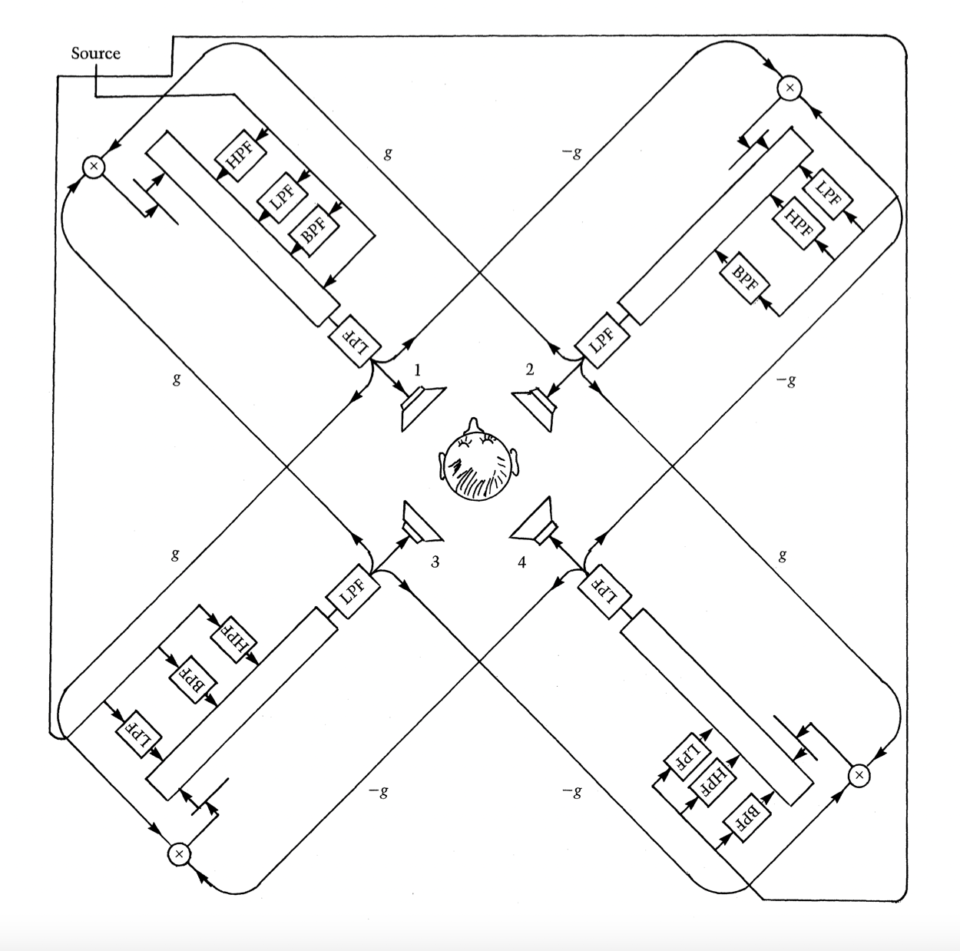Getting Started With Reverb Design, Part 2: The Best Papers

Best Academic Papers on Digital Reverb
Digital reverberation algorithms are a relatively young technology. The first published works in this field date to 1961, but it wasn’t until the late 1970s that the first commercial digital reverberators became available and would be heard on popular recordings. There have been a lot of great papers published on the topic of digital reverb, but there are 10 papers that, in my opinion, can be considered the foundations of all algorithmic digital reverbs that followed.
“Colorless” Artificial Reverberation by Manfred Schroeder
Journal of the Audio Engineering Society, 1961. This paper was the first one (as far as I know) to introduce the idea of digital reverberation, as well as the allpass delay line. Schroeder showed how to use both feedforward and feedback around a digital delay, to create a “colorless” delay block, in that it passed all frequencies at unity gain. These allpass delays could be cascaded, with each one increasing the echo density without adding coloration. The resulting reverberator structure is a bit hard to tune, as both the reverb attack and decay are controlled by the feedforward/feedback allpass coefficient, and is less “general purpose” than the structure discussed in Schoeder’s next paper. However, there are many modern reverbs that extend upon the basic concepts in this paper, by connecting a high number of allpass delays in series, and embracing the weird and wonderful results.
Natural Sounding Artificial Reverberation by Manfred Schroeder
Journal of the Audio Engineering Society, July 1962. In this seminal work, Schroeder extended upon his cascaded allpass delay work from the 1962 paper, and showed how to combine comb delays with short allpass delays. This architecture, which is what is commonly referred to as the “Schroeder reverb” nowadays, uses parallel comb delays of different delay lengths, where the feedback is used to control the overall reverb decay (more feedback = longer delay). The outputs of the parallel comb delays are summed together, and sent through two short allpass delays in series. The short series allpass delays increase the echo density – this is a technique used by reverb developers to this day. Schroeder also shows how to transpose the order of the series allpasses and parallel combs, where the outputs of the parallel combs are combined in a matrix to obtain decorrelated multichannel outputs. Again, this is a useful technique today.
Synthetic Stereo Reverberation (Part 1) by Michael Gerzon
Studio Sound, December 1971, pp. 632-635. This paper was so ahead of its time that it blows my mind. In this paper, Gerzon establishes the concept of feedback delay networks, where several parallel delays are combined with a unitary matrix (orthogonal in Gerzon’s paper), and the outputs of the matrix are sent back into the delay inputs. This creates a stable reverberator, where the echo density grows over time – a characteristic found in a real acoustic space, but not in the Schroeder reverbs. Gerzon shows how to create a higher order unitary matrix out of 2×2 rotation matrices, and how to use the rotation angles to control the spread of reverberation between the left and right channels – a useful trick to this day.
Synthetic Studio Reverberation (Part 2) by Michael Gerzon
Studio Sound, January 1972, pp. 24-28. I first read this paper 20 years ago, and am still learning new things from it to this day. In this paper, Gerzon takes the concept of feedback delay networks from his previous paper, and extends it to allpass feedback delay networks and cascaded unitary networks. Gerzon also describes how to add filters within these unitary networks to obtain a frequency dependent decay time, as found in a real acoustic space, and even describes how to replace the feedforward & feedback multipliers of an allpass delay with filters in such a way that the output is still allpass. This quote is very simple, but understanding the ramifications of it can fill a lifetime of reverberator design: “By repeated applications of feedback networks and of cascading, a wide variety of unitary networks can be created out of just a few basic unitary circuits.”
About This Reverberation Business by James Moorer
Computer Music Journal, June 1979. Moorer’s paper starts with the basic concepts from Schroeder’s work, and extends it in several ways. The 2-multiply allpass delay used by Moorer quickly became adopted as a standard building block, as it is more efficient than the Schroeder 3-multiply allpass. Moorer proposes using lowpass filters within comb filters to more accurately model high frequency damping, and also uses a sparse FIR filter (i.e. a tapped delay line) to directly model early reflections while using the comb/allpass networks for late reverberation.
Designing Multi-Channel Reverberators by John Stautner and Miller Puckette
Computer Music Journal, Spring 1982. The Stautner/Puckette paper is notable for introducing the concept of feedback delay networks to a wider audience. Gerzon had proposed these concepts in 1971, but in a publication (Studio Sound) that was virtually unavailable in the United States, so the Stautner/Puckette paper can be viewed as a case of convergent evolution. I have a soft spot in my heart for this paper, as it was the first reverb algorithm I successfully implemented, using Csound in 1999. The algorithm in the paper comes with Music 11 source code, so it is easy to adapt to other platforms. The Stautner/Puckette paper was the first one I know of to feature slow delay length modulation as a way of improving the sound, although this had been used in commercial reverbs since the EMT-250 in 1976. Low-frequency random signals are used to modulate the delay lengths, and the settings in the paper sound really nice.
A New Approach to Digital Reverberation using Closed Waveguide Networks by Julius O. Smith
Proceedings of the 1985 International Computer Music Conference, Vancouver. 1985, pp. 47–53. Julius’ paper introduces the idea of using waveguides (bi-directional delay lines) to construct reverberators. Lots of cool illustrations in this paper, with amazingly convoluted spaghetti nests used for reverb. Many of the concepts in this paper were later adapted to feedback delay networks, including using a “waveguide junction” as a scattering matrix, as well as some of the modulation techniques suggested by Smith.
Digital delay networks for designing artificial reverberators by Jean-Marc Jot and Antoine Chaigne
Proc. AES 90th Convention, Paris, France, Feb. 1991. In this paper, Jot and Chaigne introduce the concept where every delay line in a feedback delay network has its own damping filter, where the damping is designed so that all the delay lines have the same decay rate for all frequencies. This is intended to reduce metallic resonances in the decay, where some eigenmodes decay at a longer rate than others. Jot has continued to publish useful reverb papers for the past 30 years – his website is a treasure trove of reverb design content.
A Realtime Multichannel Room Simulator by Bill Gardner
Presented at the 124th meeting of the Acoustical Society of America, New Orleans, November, 1992. Gardner’s paper serves as the first public introduction of the type of reverb I refer to as an “allpass loop.” These reverb consist of several allpasses in series, embedded within a larger delay loop, where the feedback gain around the loop determines the decay time. Gardner gives specific examples of allpass loops for small, medium and large reverbs, and also discusses using nested allpass delays, which consist of allpass delays embedded within the feedforward/feedback loop of another allpass delay.
Some of these concepts were discussed in Gerzon’s 1972 paper, and Gardner mentions that he first learned many of these ideas while working in the electronic musical instrument industry. However, as far as I know, Gardner’s paper was the first time that these concepts were discussed in public literature. Gardner’s paper is also a useful reference for using a single memory buffer, and reading from and writing to that buffer to create allpass delays, nested allpass delays, and larger feedback loops.
Effect Design, Part I: Reverberator and Other Filters by Jon Dattorro
Journal of the Audio Engineering Society, Vol. 45, No. 9, September 1997. Whereas Gardner’s paper alludes to concepts that had been privately circulating within the music technology industry, Dattorro’s paper fully opened the vault doors on the allpass loop reverbs. Dattorro’s introduces a specific allpass loop reverb in great detail, complete with all delay lengths and coefficients, “in the style of [Lexicon’s] Griesigner.” This paper can be viewed as a Rosetta Stone of reverb design, and many plugins and built-in synth reverbs have exactly recreated the “Dattorro” reverb. Dattorro also includes very informative comments from Barry Blesser, the designer of the EMT-250 reverb algorithms, that explain why delay line modulation was originally included in commercial reverberators. A must-read paper.




I just started my college senior project and I can’t tell you how grateful I am for this blog post. Thank you!
I think i found one case where the three multiply all pass can be more efficient. If you have a DSP with two MAC units and no register file and the two MACs can parallel load the same data but you have a pipeline delay for the MAC, you can do a five cycle three multiply all pass (including reading the input and writing the output) depending on the pipeline.
Read AP1 tail, MAC1 gx MAC2 (1-g2)x
Read AP1 head, MAC1 A+x MAC2 A-gx
pipeline delay.
Write MAC1 A to AP1 head
Write MAC2 A to AP1 tail
In this case the two multiply all pass is slower because you have to complete one of the all pass MACs (half the all pass) before starting on the second half of the allpass, this one gains speed because both MAC units operate on the same two data points simultaneously. The pipeline delay can be used to read the next AP tail.
Thanks for this fantastic resource! Have these papers and principles collected here, as well information about industry personalities and secrecy, is extremely useful to me.
You may conceivably remember me from woof user group meetings at Columbia in the late 1980s….
I’ve been a long time user of your FDN reverb design in Csound (both the original Csound orc credited to you and J. Lato and the C adaptation of it by Istvan Varga as the reverbsc opcode).
Thank you for these posts Sean!